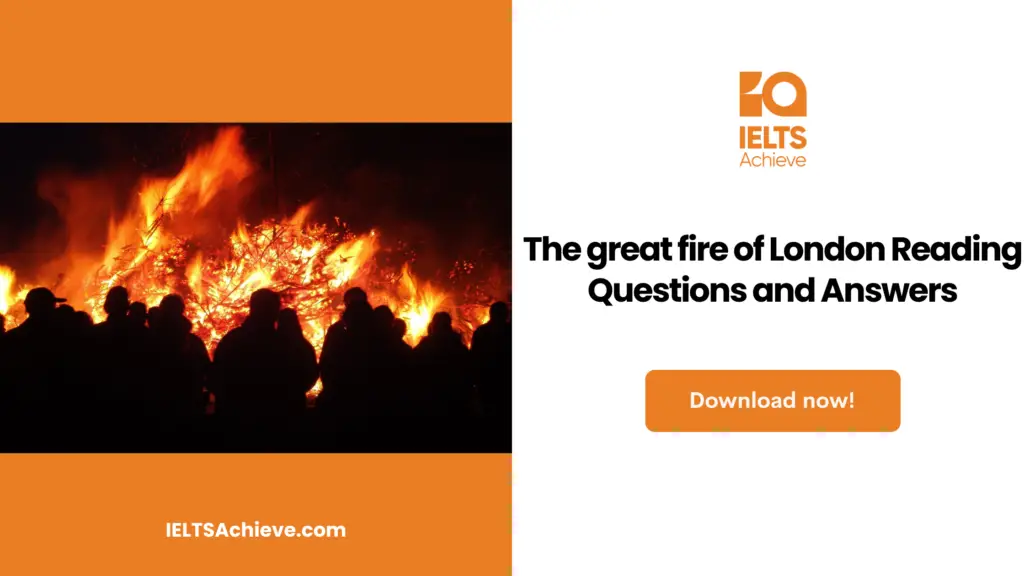The Blog post contains the following IELTS Reading Questions:
- IELTS reading matching headings
- IELTS reading multiple choice questions
- IELTS reading Sentence Completion
Stay informed and prepared for success – Explore our comprehensive Reading Test Info page to get valuable insights, exam format details, and expert tips for mastering the IELTS Reading section.
IELTS Reading Passage: The great fire of London

The great fire of London
A. The Great Fire of London destroyed 13,200 homes and 87 parish churches in September 1666. Three other medieval structures, the Royal Exchange, the Guildhall, and St. Paul’s Cathedral, were also wiped out. There were only six confirmed deaths in the Great Fire of London, but many more people perished as a result of smoke inhalation and other complications. At a time when London’s annual income was only £12,000, the fire was estimated to have caused £10 million in damages financially. Debtors’ prisons swelled as many people lost all of their money.
B. On Sunday, 2 September 1666, a fire started in Thomas Farynor’s bakery on Pudding Lane, setting off a chain reaction that eventually destroyed much of London. Even though he said he put out the fire, it rekindled three hours later at 1 in the morning. A spark from Farynor’s oven may have fallen onto a nearby pile of fuel and started the fire, though this cannot be proven. In 1979, archaeologists unearthed the charred remains of a bakery’s neighbor on Pudding Lane, suggesting that the fire may have started there. Twenty pitch barrels were found in the cellar with their contents completely burned out. Due to its high combustibility, the pitch would have contributed to the fire’s rapid spread.
C. Rapidly consuming everything in its path, the blaze raced down Pudding Lane, across Fish Hill, and into the Thames. An intense wind from the east aided the fire’s rapid progression, which continued unabated. Warehouses stocked with oil and rope caught fire when the blaze made its way to the Thames. Thankfully, because of the damage done to London Bridge in 1633, the fire could not spread south of the river. Since the fire was spreading so rapidly, most Londoners prioritized getting out of the city rather than trying to put it out.
D. There was less of an awareness of fire safety in the 17th century than there is now. The buildings were constructed of wood that had been coated in pitch. Buildings were constructed in a way that allowed the fire to easily jump from one to another. The city had been hit hard by drought after a particularly dry summer, with water in short supply and the wooden homes dried out and more prone to catching fire.
E. It was noted by Samuel Pepys, a contemporary diarist, and Clerk to the Royal Navy, that the only way to put out the blaze might be to tear down buildings, so he suggested this plan to the King. The Mayor had ordered the use of fire hooks to pull down the burning structures, but the fire had already spread too far. After consulting with the Navy’s admiral, Pepys decided it would be best to blow up homes in the path of the blaze. The plan was to make enough room between the buildings to prevent the fire from spreading. The Navy responded to the call, and by morning, the blaze had been extinguished.
F. Because of the extensive rebuilding that was necessary for London, many residents fled to the suburbs and countryside. Some people were compelled to endure such conditions for months, while others stayed there for days. Throughout the year 1667, residents of the charred region worked to clear away debris and conduct an inventory of the damage. New street plans and construction codes took a lot of time to develop. New coal taxes funded public construction, but by year’s end only 150 new homes had been built. The purpose of the new rules is to ensure that nothing like the recent disaster ever occurs again. Brick was mandated to replace wooden cladding on new construction. Roads got some extra room and two brand new ones were built. London’s quays were upgraded with the installation of new pavement, sewers, and lighting. However, at first, only temporary buildings were erected, and these lacked the necessary equipment to prevent the spread of the plague, which was common in London at the time. This, combined with the harsh winter that followed the fire, was responsible for the deaths of a great number of people.
G. A modern fire department did not exist in 1666. Putting out fires required little in the way of training or expertise. Many attempts were made to put out the fire using leather buckets, axes, and water squirts, but none of these were successful. As a direct response to the devastation caused by the Great Fire of London, insurance firms quickly organized the first fire departments. Due to the lucrative nature of building insurance, many more insurance providers sprung up, each with its own fire department. In the event of a fire, these brigades were dispatched to insured properties in an effort to limit losses. Various insurance providers would use fire marks as a means of advertising their services to policyholders. Brigades would check for them on the outside of a building to see if it was covered by their insurance. Multiple fire companies would respond to a major blaze. Without their unique fire mark displayed on the structure, they would abandon the home to the flames. Buildings in London often show signs of previous fires. In addition, fire departments were given the option to wear uniforms of varying colors to help them stand out from competing insurance companies. However, despite this positive development, firefighters still only received minimal training and used outdated equipment.
Glossary
Pitch is an oily or tarry substance that can be found in petroleum or coal.
Unlock your full potential in the IELTS Reading section – Visit our IELTS Reading Practice Question Answer page now!
Recommended Questions:
Renewable Energy IELTS Reading Question with Answer
IELTS Reading Questions: The great fire of London
Questions 1-7
The text on the reading passage has 7 paragraphs (A-G) .Choose the correct heading for each paragraph from the list of headings below. Write the correct number (i-x) in boxes 1-7 on your answer sheet.
i. The Movement of the Fire
ii. The Costs
iii. The Smoke’s Repercussions
iv. New London
v. Suppressing the Flames
vi. Vulnerable Buildings
vii. The Origins
viii. Low Food Supply
ix. Implications for Business
x. A Bright Side to the Ruins
Question 1: ____
Question 2: ____
Question 3: ____
Question 4: ____
Question 5: ____
Question 6: ____
Question 7: ____
Ready to conquer Matching Headings questions? Click here to learn essential tips and techniques for matching headings accurately to paragraphs or sections in the IELTS Reading section.
Questions 8-11
Choose FOUR letters, A-G. What FOUR of the following were effects of the Great Fire of London? Write the correct letter, A-G, in any order in boxes 8-11 on your answer sheet.
- The government conducted an investigation to determine what caused the extensive damage.
- The ease with which disease could spread was greatly increased.
- Efforts to combat fires have begun.
- There was a period of 18 months during which the English royal family had to relocate outside of London.
- The destruction of London’s commercial sector benefited the French economy.
- The official death toll was six.
- In the years after the fire, some people were forced to make do in the fields.
Question 8: ____
Question 9: ____
Question 10: ____
Question 11: ____
Ready to improve your performance in Multiple Choice Questions (MCQs)? Click here to access our comprehensive guide on how to tackle MCQs effectively in the IELTS Reading section.
Questions 12-13
Complete the sentences below.
Write NO MORE THAN THREE WORDS from the text for each answer. Write your answers in boxes 12-13 on your answer sheet.
12. Having ………………………….. facades on future London homes was one measure taken to reduce the number of fires.
13. Consumers might distinguish fire departments from insurance businesses based on their …………………………..
Enhance your sentence completion skills in the IELTS Reading section. Click here to access our comprehensive guide and learn effective strategies for filling in missing words or phrases in sentences.
Unlock your full potential in the IELTS Reading section – Visit our IELTS Reading Practice Question Answer page now!
Recommended Questions:
Renewable Energy IELTS Reading Question with Answer
The great fire of London reading answers
1. ii
2. vii
3. i
4. vi
5. v
6. iv
7. x
8. F
9. G
10. B
11. C
12. Brick
13. Uniforms

We hope you found this post useful in helping you to study for the IELTS Test. If you have any questions please let us know in the comments below or on the Facebook page.
The best way to keep up to date with posts like this is to like us on Facebook, then follow us on Instagram and Pinterest. If you need help preparing for the IELTS Test, join the IELTS Achieve Academy and see how we can assist you to achieve your desired band score. We offer an essay correction service, mock exams and online courses.

